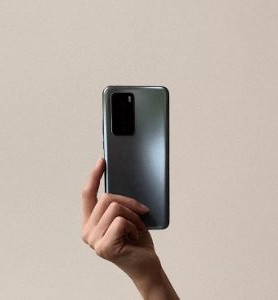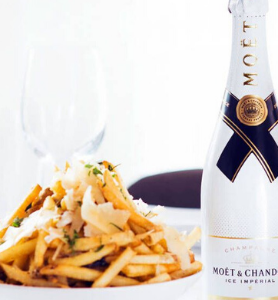Sunflowers, surf and solitude: Meet artist Nick Herd
For Kiama-based artist Nick Herd, painting is a means of expelling energy. Here, he tells me about the artists whose work he admires, a sunflower at home he once painted, and the joys found in a solitary practice.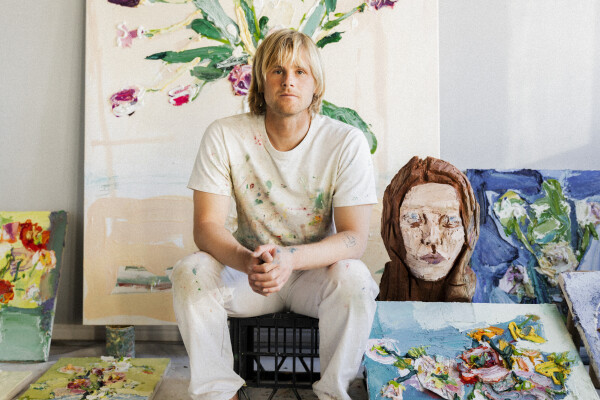
Tell me about your current artistic practice—what is it that appeals to you about these almost larger than life, voluminous forms?
I’ve always been drawn to the physicality of oil paint and how you can manipulate it in many ways. I approach it in a child-like manner, almost treating it as pigmented mud. My application takes many shapes, but most of the time it comes straight from the paint tube to the canvas. For me, I have all this energy that I need to expel, and painting is where that energy goes. I paint quite quickly, and the process is full of quite quirky moments. I could liken it to a piece of music. The paintwork builds and builds in an all-or-nothing manner filled with playful dollops of paint or colour that excite me. I love physically defacing and scraping back into dried oil paint with my large palette knives to reveal earlier moments of the painting. There are all sorts of textures to be explored with oil paint; it provides the freedom to create without having to abide by any rules! Half the time, I’m not sure what the outcome will be. That’s the exciting part, the spontaneity of it, which can also be scary at times, if you stop and fixate... overthinking a work can kill the creative process. I find myself pulled toward large- scale paintings, most often larger than the form of the subject sitting in front of me. I feel scale can give a painting power over me, inviting me to step in and get lost in the world of it. I find especially with the larger pieces I make, there is an amazing variety in the experience of painting it, depending on what distance I am making the marks from. Painting big demands my everything to achieve the work. My entire body and mind are involved, and I end up feeling transported to a different realm, almost through a meditative state. I sometimes don’t know how I’ve realised parts of the painting, but I do always leave the studio covered head to toe in oil paint.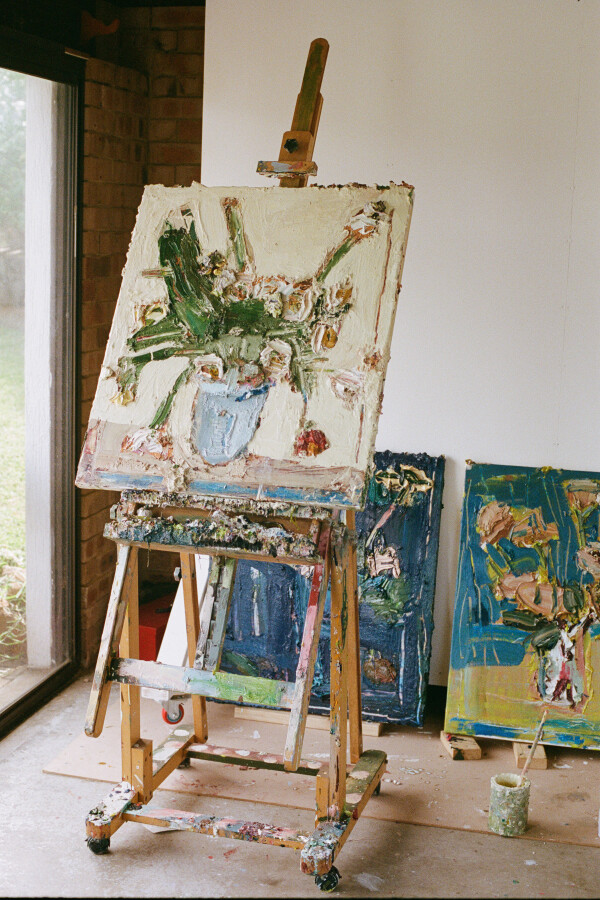
Tell me more about your creative spaces—what kind of setting helps you feel most creative?
Although it can sometimes be a luxury as an artist, open space and lots of room to breathe and think, new studio spaces can feel a little stagnant initially, with nothing really happening. Though I love it when you start developing a body of work and start creating mess. The room starts building character and starts to not feel sterile. There’s got to be paint on the floors or walls. I quite enjoy creating chaos at times. Once I’m deep in the painting process, I’m almost always guaranteed to start tripping over my oil paint cans as I’m too focused to put things away. Eventually, I will clean up the mess and look at what I’ve created. It’s an exhilarating cycle. A key ingredient for my making process is natural light; I can’t work in artificially lit scenarios. There’s got to be light and energy beaming through some sort of window. The more natural light, the better. As the light moves and changes throughout the day, my paintings also are evolving and being viewed in an environment with different stages of light. It breathes a certain life into the process and is an important part of how I work; it has naturally crept in over the years.
Art can be quite solitary. What does community mean to you?
It can be very solitary, which on the positive side is an opportunity to build a healthy relationship with yourself and really enjoy your time alone. Putting aside, community is really everything. I’ve been lucky to live in different communities within Australia and New Zealand. At the moment I live in Kiama, which is just under a couple of hours’ drive down the coast from Sydney. I surf every morning and I’ve made friendships with people in and out of the water in the area, including my neighbours, who are now friends. It’s special to think that we are all a community with each person bringing their own something to the table, which can be shared with one another. Sometimes in the bigger cities, communities can get a little lost. But even then, I think it’s very natural to find a community within it.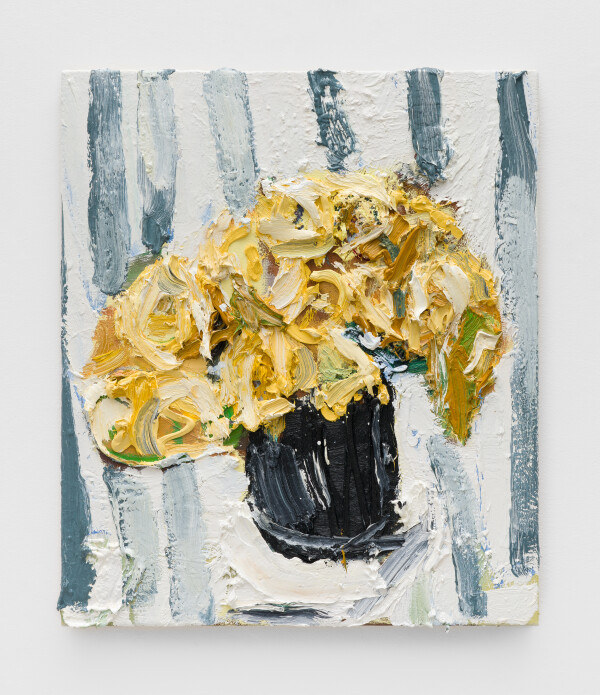
What are some of the joys of being an artist?
My partner, Tilly, will laugh and agree with me here. I don’t like being told what to do. I think a lot of artists have that inside of them. With that comes freedom, and it’s one of the biggest joys in my life.
Who are some names that you look to for inspiration, in any field?
I have a thing for naivety in painting. Rose Wylie is a contemporary artist I enjoy following. Her simple compositions, colours and subjects are unique and just fantastic. You can’t teach what she does, check her out! Henry Taylor— he’s the lord of portraits. Finally, women’s fashion labels—the colour combinations are just amazing. They are just so dialled in. I feel like there’s a hidden link with painters who have the eye for colour combinations and fashion labels that do the same. I think they both feed off one another. I buy extra-large women’s shirts—you simply don’t get the colours in menswear.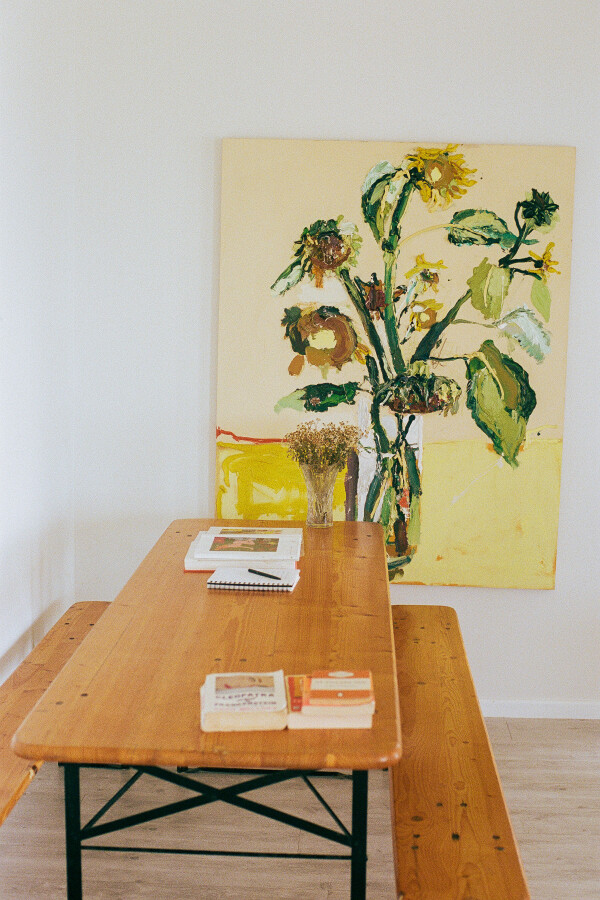
You are now based in Australia. Does being away from New Zealand have a certain pull? What is it like when you return?
I grew up in Auckland, where I also spent my young adult years. My parents moved away from Auckland a few years ago. So I have friends there who are like family. But I have built a life over here in Australia now. I have my routines, passions, loves and community here. It’s hard to put into words, still very familiar—it’s like going back to your parents’ house once you have moved away. There is and will always be somewhat of a home feeling. I’m proud to be a New Zealander. I was in New Zealand recently, walking along the boardwalk in Devonport, and I started getting a pool of old memories that I thought were special. I think there’s some sort of special connection there.
Do you have a favourite piece you’ve created? Why?
My brother and I were living together in Sydney for a while. We planted these Giant Russian Sunflower seeds around the property we were living in. We watered them religiously, and there was this one spot where all the rainwater would run to. So this sunflower was in luck and stood in the best possible spot. It grew to at least double the height of me. Its root was thick as a tree, and at least fifteen sunflower heads were coming off it. At the time, I had the house to myself and turned it into a studio. I ended up cutting down the sunflower as the cockatoos started eating it. So I spent a couple of days painting it, along with its half-eaten heads the size of dinner plates. I surfed and painted, and surfed and painted. It was painted in a style I had not tried before. I’ve still got the original, and won’t ever sell it.
Is there anything else that Remix readers should know about you?
I cannot get enough of movies and have a baby boy due any moment now.



